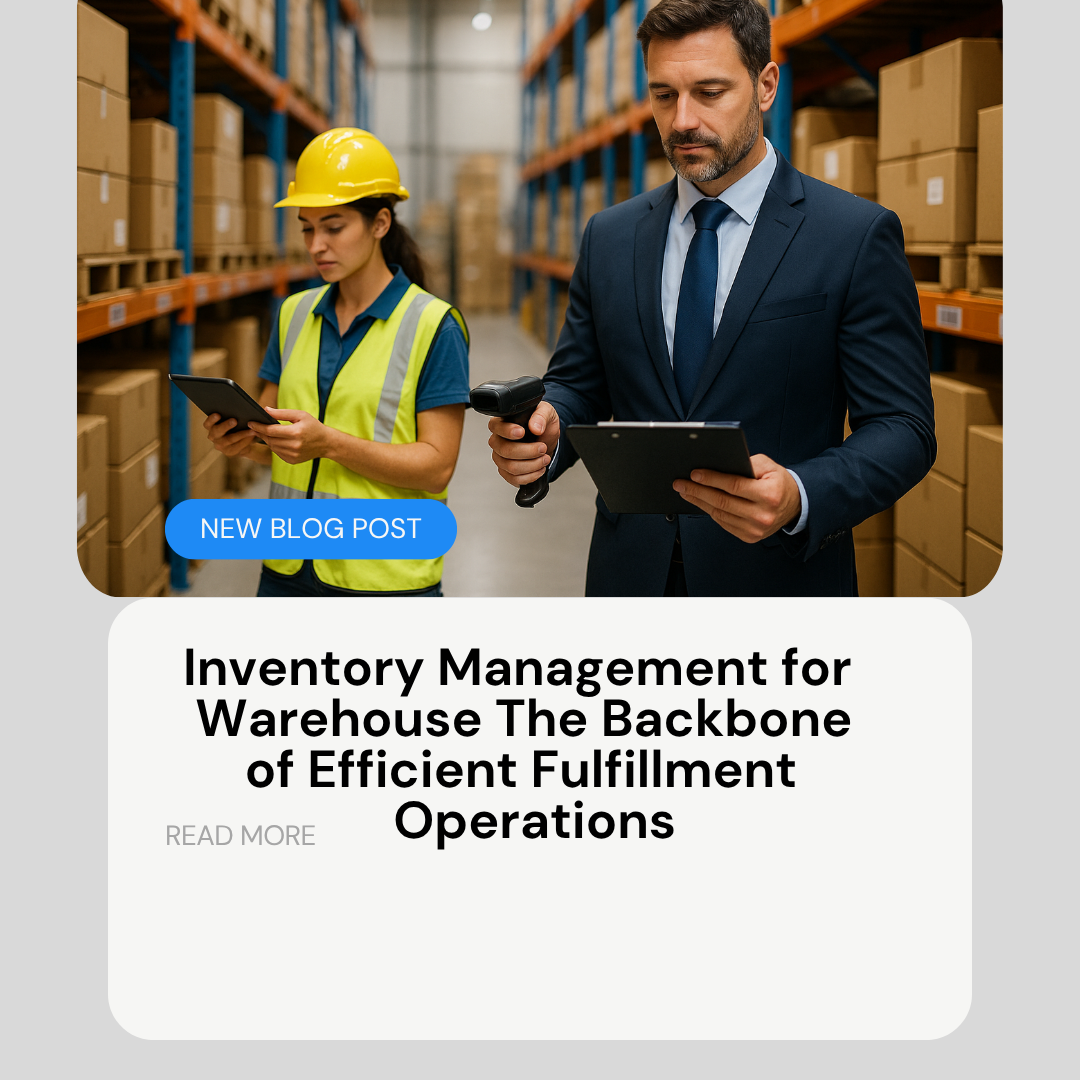Inventory Management for Warehouse The Backbone of Efficient Fulfillment Operations
Inventory Management for Warehouse The Backbone of Efficient Fulfillment Operations

Table of Contents
In the fast-paced world of logistics and eCommerce, inventory management has emerged as one of the most critical aspects of running a successful supply chain. Whether you’re a retailer, manufacturer, or online seller, efficient inventory management can make the difference between profitability and loss.
For growing enterprises that depend on timely deliveries, real-time stock tracking, and customer satisfaction, warehouse inventory management isn’t just an operational task — it’s a strategic advantage.
At Coastal Distributions Group, we understand the complexities of modern inventory management. Our solutions empower businesses to optimize their warehouse operations, reduce storage costs, and enhance overall supply chain performance through innovation, precision, and reliability.
This comprehensive guide explores the fundamentals, technologies, and best practices of inventory management for warehouses, and how Coastal Distributions Group helps companies streamline their logistics for scalable growth.
Understanding Inventory Management in Warehousing
What is Inventory Management?
Inventory management is the process of efficiently overseeing the flow of goods within a warehouse — from receiving and storing products to tracking and shipping them to customers or retailers.
It involves maintaining the right balance of stock:
- Not too much (to avoid excess costs)
- Not too little (to prevent stockouts)
Effective inventory management ensures that goods are available when and where they’re needed, minimizing delays and maximizing customer satisfaction.
Why It Matters for Businesses
Every business — whether B2B or B2C — depends on inventory accuracy. Poor inventory control can lead to:
- Overstocks and wasted warehouse space
- Lost sales due to unavailable products
- Inefficient order fulfillment
- High operational costs
With precise inventory management, businesses gain visibility, efficiency, and profitability — essential ingredients for long-term success.
The Role of a Warehouse in Inventory Management
A warehouse is not just a storage facility — it’s the operational core of the entire supply chain. It enables:
- Efficient product organization and retrieval
- Faster fulfillment for customer orders
- Accurate stock tracking
- Quality control and packaging operations
Modern warehouses like those operated by Coastal Distributions Group go beyond simple storage. They integrate smart inventory systems, automated tracking, and real-time analytics to provide full transparency across every movement of goods.
This level of sophistication allows companies to scale confidently while maintaining accuracy and efficiency.
- The Key Elements of Inventory Management in Warehouses
Effective inventory management consists of several interconnected processes. Here are the most important components:
- Stock Receiving
Efficient inventory management begins at the receiving dock. Each incoming shipment must be accurately logged, verified, and entered into the system to ensure consistency and traceability.
- Storage and Organization
Products should be stored in logical, accessible locations — categorized by SKU, size, demand frequency, or seasonality — to streamline picking and packing operations.
- Order Picking
Warehouse staff or automated systems pick the right products from storage based on customer orders. The accuracy of this process directly impacts customer satisfaction.
- Packing and Labeling
Proper packaging ensures product safety during transportation, while correct labeling supports smooth delivery and tracking.
- Shipping and Distribution
Once orders are packed, they’re dispatched through reliable transportation networks. Coastal Distributions Group ensures that goods reach destinations efficiently through optimized logistics channels.
- Returns Management
Handling returns is just as crucial. Efficient reverse logistics processes maintain inventory accuracy and reduce operational waste.
Inventory Management Methods
Different businesses adopt different methods for managing inventory, depending on product type, demand cycles, and sales patterns.
- Just-in-Time (JIT)
Inventory is replenished only when needed, minimizing the products and holding costs. However, this method requires highly reliable suppliers.
- First-In, First-Out (FIFO)
Older inventory is sold first. Ideal for perishable goods or items with shelf lives.
- Last-In, First-Out (LIFO)
Newer inventory is used first. Suitable for non-perishable, fast-moving items.
- ABC Analysis
Inventory is categorized into three groups:
- A: High-value, low-quantity items
- B: Moderate value and frequency
- C: Low-value, high-quantity items
This prioritization helps allocate resources efficiently.
- Safety Stock and Reorder Point
Maintaining a buffer stock ensures that unexpected demand spikes or supply delays don’t halt operations.
Common Challenges in Warehouse Inventory Management
Even well-organized warehouses face challenges that can affect operational efficiency. Common issues include:
- Inaccurate Data: Manual errors in stock entry or outdated records.
- Overstocking or Understocking: Poor forecasting leads to excess inventory or stockouts.
- Lack of Visibility: Inability to track real-time stock movement.
- Inefficient Space Utilization: Poor layout design results in wasted storage capacity.
- Slow Fulfillment: Ineffective processes delay deliveries.
- Returns Management: Mishandling returns disrupts inventory accuracy.
Coastal Distributions Group addresses these challenges by integrating technology-driven solutions with strategic warehouse design and professional staff expertise.
Technologies Revolutionizing Inventory Management
The warehouse industry has undergone a technological revolution. Advanced digital systems are now the foundation of successful inventory management.
A WMS provides real-time tracking of stock levels, orders, and shipments. It automates manual processes, reducing errors and improving accuracy.
- Barcode and RFID Scanning
These technologies enable instant identification and movement tracking of goods — essential for large warehouses with thousands of SKUs.
- Cloud-Based Inventory Platforms
Cloud technology allows centralized control over multiple warehouses. Coastal Distributions Group uses cloud-based systems to synchronize inventory data across all facilities.
- Automation and Robotics
Automated picking systems, conveyor belts, and sorting robots significantly enhance speed and precision.
- AI and Data Analytics
Artificial Intelligence analyzes demand patterns, forecasts future needs, and helps in predictive replenishment.
- IoT Integration
Smart sensors track temperature, humidity, and real-time inventory conditions — critical for perishable or sensitive goods.
- Blockchain Technology
Blockchain ensures transparency and traceability across the supply chain — a game-changer for industries like pharmaceuticals and luxury goods.
Coastal Distributions Group’s Approach to Warehouse Inventory Management
At Coastal Distributions Group, we don’t just manage inventory — we engineer efficiency.
Our Core Principles:
- Accuracy: Every product is scanned, tracked, and verified using advanced barcode and RFID systems.
- Transparency: Clients have real-time visibility into inventory movements through cloud dashboards.
- Optimization: Warehouses are strategically located to minimize transit times.
- Customization: Tailored inventory systems for each client’s product type and order volume.
- Scalability: As your business grows, our infrastructure grows with you.
Our goal is to eliminate waste, improve fulfillment speed, and enhance profitability through innovative warehouse management systems.
The Importance of Data and Analytics in Inventory Management
Data is the new logistics currency. By analyzing historical sales data, seasonal trends, and customer demand, companies can make smarter inventory decisions.
Predictive Analytics
Using machine learning algorithms, predictive analytics helps forecast inventory needs accurately — reducing the risk of stockouts or overstocks.
Performance Metrics
Key performance indicators (KPIs) such as order accuracy, inventory turnover, and carrying costs provide valuable insights for continuous improvement.
At Coastal Distributions Group, data-driven decision-making is central to our warehouse operations. Our systems provide transparent reporting that empowers clients to make informed business choices.
The Link Between Inventory Management and Customer Satisfaction
In the digital age, customers expect instant availability and rapid delivery. Poor inventory management can directly harm customer trust.
For instance:
- Late deliveries due to stockouts frustrate buyers.
- Inaccurate stock listings lead to canceled orders.
- Damaged or misplaced goods affect brand reputation.
An efficient inventory system ensures that customers always receive the right product, at the right time, in perfect condition.
Coastal Distributions Group’s fulfillment centers are designed to deliver excellence at every stage — from order picking to final delivery.
Sustainability in Warehouse Inventory Management
Sustainability has become a defining factor in logistics strategy. Efficient inventory management contributes to eco-friendly operations by:
- Reducing waste through optimized stock levels
- Lowering energy consumption with smart automation
- Utilizing eco-friendly packaging and materials
- Enhancing transportation efficiency to minimize emissions
Coastal Distributions Group is committed to sustainable warehouse practices, integrating green technologies and energy-efficient designs into our operations.
Future Trends in Inventory Management
The next generation of warehouse inventory management will be powered by automation, AI, and real-time connectivity. Here’s what the future holds:
- Smart Warehouses
Warehouses will operate as autonomous ecosystems — robots picking items, AI scheduling tasks, and drones performing stock audits.
- Predictive Replenishment
AI will anticipate demand fluctuations and reorder stock automatically.
- Integrated Omnichannel Logistics
Businesses will manage inventory seamlessly across online and offline sales channels.
- Blockchain and Supply Chain Visibility
Immutable digital ledgers will track every product journey, ensuring complete transparency.
- Micro-Fulfillment Centers
Smaller, urban-based warehouses will enable same-day or 2-hour deliveries for eCommerce orders.
- Why Choose Coastal Distributions Group
For businesses seeking reliable, technology-driven inventory and warehouse management solutions, Coastal Distributions Group stands as a trusted logistics partner.
Our Advantages:
- Strategically located fulfillment centers for faster delivery
- Cutting-edge warehouse management technology
- Highly trained logistics professionals
- Tailored solutions for B2B and B2C clients
- Full transparency and reporting for all clients
Whether you’re an eCommerce retailer, manufacturer, or wholesale distributor, we help you build a smarter, more resilient supply chain — one that grows with your business.
Conclusion
Effective inventory management for warehouses is not just about storing products — it’s about driving business success through efficiency, visibility, and innovation.
As global trade continues to expand, businesses that leverage advanced inventory systems and trusted partners like Coastal Distributions Group will gain a lasting competitive advantage.
From accurate forecasting and optimized space utilization to cutting-edge technology integration, Coastal Distributions Group empowers clients to achieve operational excellence at every stage of the logistics journey.
Because in today’s supply chain world — precision is power.



